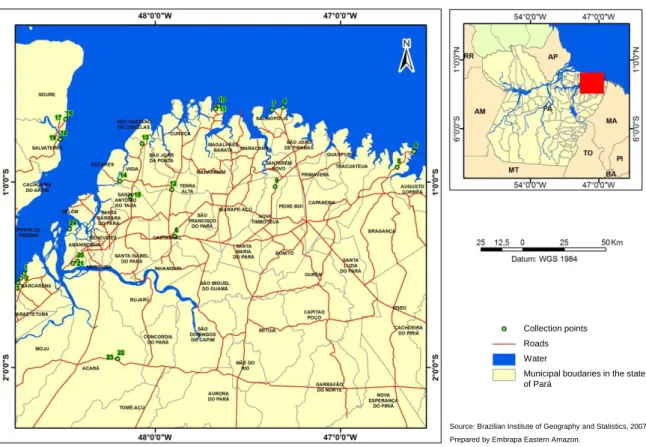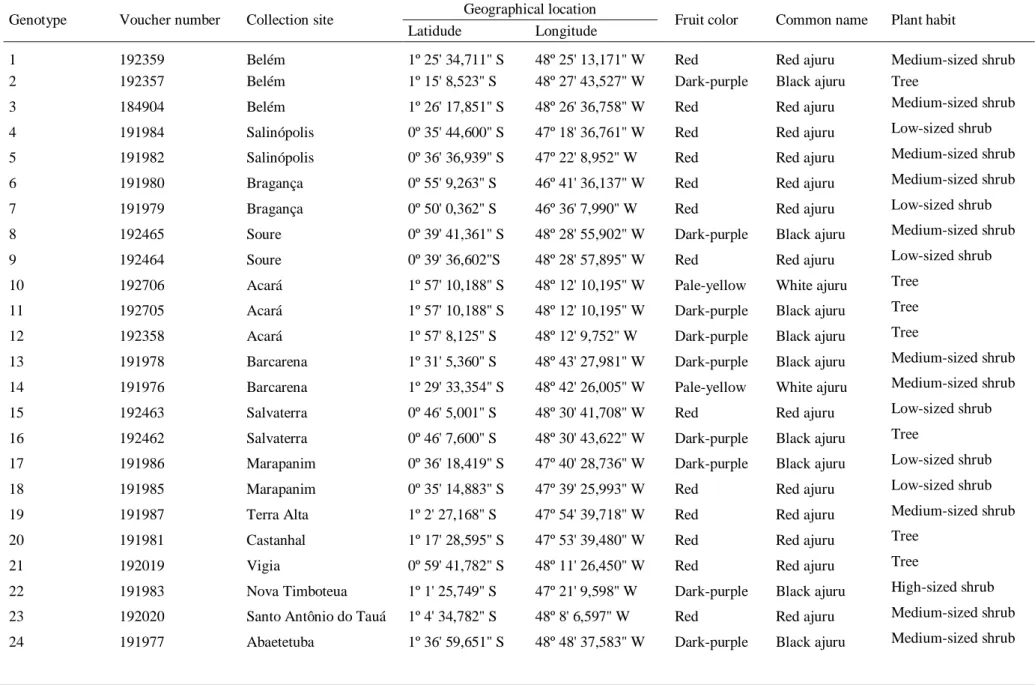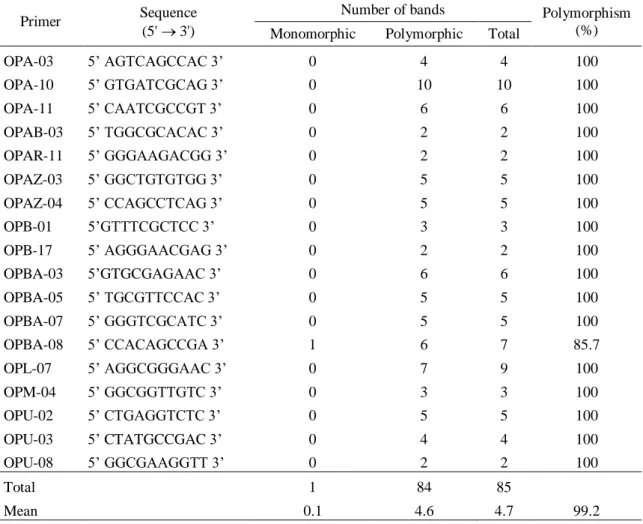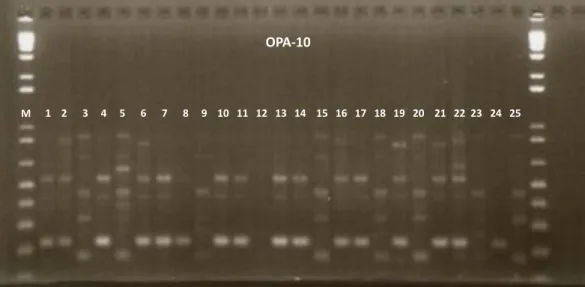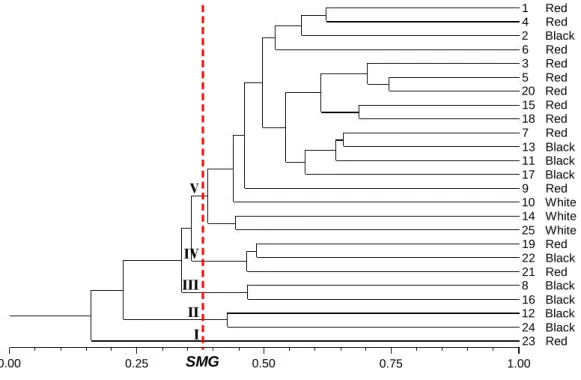Genetic fingerprinting of the Brazilian medicinal plant Chrysobalanus
icaco L. (Chrysobalanaceae)
Impressão digital genética da espécie medicinal brasileira Chrysobalanus
icaco L. (Chrysobalanaceae)
DOI:10.34117/bjdv6n11-151
Recebimento dos originais: 09/10/2020 Aceitação para publicação: 09/11/2020
Nádia Elígia Nunes Pinto Paracampo
PhD in Chemistry Embrapa Eastern Amazon
Tv. Dr. Enéas Pinheiro SN, Marco, Belém - PA, Brazil, 66095-903, PO Box 48 nadia.paracampo@embrapa.br
Maria do Socorro Padilha de Oliveira
PhD in Genetics and Plant Breeding Embrapa Eastern Amazon
Tv. Dr. Enéas Pinheiro SN, Marco, Belém - PA, Brazil, 66095-903, PO Box 48 socorro-padilha.oliveira@embrapa.br
Ghillean Tolmie Prance
PhD in Botany
Herbarium, Royal Botanic Gardens, Kew Richmond, Surrey, TW9 3AD, UK
siriain01@yahoo.co.uk
Ronei Jesus Poppi
PhD in Chemistry
Institute of Chemistry, State University of Campinas
R. Josué de Castro SN, Cidade Universitária, Campinas, SP, Brazil, 13083-861, PO Box 6154 National Institute of Science & Technology of Bioanalytics (INCTBio), Brazil
rjpoppi@unicamp.br
José Alberto Fracassi da Silva
PhD in Chemistry
Institute of Chemistry, State University of Campinas
R. Josué de Castro SN, Cidade Universitária, Campinas, SP, Brazil, 13083-861, PO Box 6154 National Institute of Science & Technology of Bioanalytics (INCTBio), Brazil
fracassi@unicamp.br
ABSTRACT
Chrysobalanus icaco L. (Chrysobalanaceae) is a medicinal species widely used in Brazil mainly to treat diabetes. Despite the medicinal importance of C. icaco, genetic information of this genus remains limited. Thus, our aim was to evaluate the influence of the genetic basis of C. icaco by determining its chemotypes. 25 C. icaco genotypes were collected from 15 sites in Belém, Marajó and Northeastern mesoregions of Pará state, Brazil. The genotypes were selected by
evaluating the plant morphological characteristics such as fruit color and plant habit. The DNA fingerprinting profile was performed using PCR based RAPD technique and appropriate statistical methods were used. RAPD markers were used for evaluation of genetic diversity and molecular characterization of the C. icaco, using a total of 18 decamer primers. These primers produced 85 amplification products, with an average of 4.7 bands per primer and 99.2% polymorphism. The genotypes are genetically distinct, forming variable clusters in number and constitution by different methods. By the morphological characteristics considered, there is a tendency of clustering based on the color of the ripe fruit. We found the secondary metabolite content depends not on environmental condition, but rather on C. icaco genome. Therefore, it may have implications for ethnopharmacological use of the chemotypes.
Keywords: Traditional Brazilian medicine, Coco-plum, Chemotype, RAPD, Genetic diversity. RESUMO
Chrysobalanus icaco L. (Chrysobalanaceae) é uma espécie medicinal amplamente utilizada no Brasil, principalmente no tratamento do diabetes. Apesar da importância medicinal de C. icaco, as informações genéticas desse gênero ainda são limitadas. Assim, nosso objetivo foi avaliar a influência da base genética de C. icaco pela determinação de seus quimiotipos. 25 genótipos de C. icaco foram coletados em 15 municípios localizados em três das mesorregiões do estado do Pará, Brasil: Metropolitana de Belém, Marajó e Nordeste Paraense. Os genótipos foram selecionados avaliando-se as características morfológicas da planta, como cor dos frutos e hábito da planta. A impressão digital de DNA foi realizada utilizando a técnica de RAPD baseada em PCR e os dados foram tratados por métodos estatísticos adequados. Marcadores RAPD foram utilizados para avaliação da diversidade genética e caracterização molecular de C. icaco, utilizando um total de 18 primers decâmeros. Esses primers produziram 85 produtos de amplificação, com média de 4,7 bandas por primer e 99,2% de polimorfismo. Os genótipos são geneticamente distintos, formando agrupamentos que variam em número e constituição, por diferentes métodos. Pelas características morfológicas consideradas, existe uma tendência de agrupamento em função da cor do fruto maduro. Descobrimos que o conteúdo de metabólitos secundários produzido pelos quimiotipos não está relacionado às condições ambientais, mas sim ao genoma de C. icaco. Portanto, isso pode ter implicações diretas no uso etnofarmacológico desses quimiotipos.
Palavras-chave: Medicina tradicional brasileira, Ajuru, Quimiotipo, RAPD, Diversidade
genética.
1 INTRODUCTION
Chrysobalanus icaco L. (Chrysobalanaceae) is a medicinal species mainly used for treating diabetes (AGRA et al., 2007; COELHO-FERREIRA, 2009; SILVA & PEIXOTO, 2009) that occurs naturally in municipalities of Pará state, Brazil. The individuals show great variation in morphological characters, especially for the size and color of ripe fruit (pale-yellow, red and dark-purple), size and shape of leaf, and growth habit (shrub and tree). It is popularly known as “ajuru-branco”, “ajuru-vermelho” or “ajuru-preto”, according to morphotype associated with the ripe fruit color: white, red and black, respectively. Although there is a
considerable amount of research evaluating biological activities of C. icaco, including hypoglycemic effect (BARBOSA et al., 2013; FERREIRA-MACHADO et al., 2014; WHITE et al., 2016), studies that elucidate this morphological variability remain scarce.
A multivariate analysis of chemical data by our group (PARACAMPO et al., 2017) showed that the C. icaco red morphotype differs from the white and black demonstrating that there are two chemotypes of C. icaco that are not phytoequivalent to each other. However, we know the chemical constituents are susceptible to environmental factors (GOBBO-NETO & LOPES, 2007). Thus, it was necessary to evaluate the genetic structure of C. icaco because DNA markers are reliable for information on genetic polymorphism, regardless of the age, physiological condition or part of the plant used (SHARMA & HEMALATHA, 2017).
Studies on genetic variability and divergence are important to establish the genetic diversity within a species and among populations of plant genetic resources, to guide management actions in areas of natural occurrence, in rational crops, as well as possible parents for breeding programs (CRUZ et al., 2011).
Nowadays, DNA fingerprinting has been widely used for documenting genetic diversity of medicinal plants (GANIE et al., 2015; SHARMA & HEMALATHA, 2017). Techniques based on the polymerase chain reaction (PCR) have been described for the authentication of medicinal plants. Among different DNA markers available, Random Amplified Polymorphic DNA (RAPD) is the most popular because of its rapidity, simplicity and low cost (MILACH, 1998; BORÉM & CAIXETA, 2016). In addition, no knowledge of the DNA sequence is required (SINGH et al., 2014). There are many studies applying RAPD markers to access genomes of medicinal species (AGUIAR et al., 2015; ZONGRAM et al., 2017).
For this work, we evaluated the DNA profiles of the 25 C. icaco samples collected from 15 different sites in Pará state, Brazil. RAPD and appropriate statistical methods were used. To the best of our knowledge, there are no previous studies assessing the genetic diversity of C. icaco.
2 MATERIAL AND METHODS
2.1 PLANT MATERIAL
Samples were collected from 25 C. icaco genotypes from 15 sites in the Belém, Marajó and Northeastern mesoregions of Pará state, Brazil (Figure 1, Geographic localities of C. icaco specimens used in this study). Fresh young leaves of wild C. icaco were collected between September and October of 2014.The genotypes were selected by evaluating the plant morphological characteristics such as fruit color and plant habit. All plant material was
authenticated by experts and voucher specimens were deposited at IAN Herbarium of Embrapa Eastern Amazon in Belém, Pará, Brazil. Information on the collection of C. icaco samples is shown in Table 1.
2.2 DNA EXTRACTION
Genomic DNA was individually extracted from the fresh young leaves of the 25 C. icaco samples using the cetyltrimethylammonium bromide (CTAB) method (DOYLE & DOYLE, 1990; COSTA & OLIVEIRA, 2002). 1.0 g of fresh leaf material was ground to a fine powder in liquid nitrogen with polyvinylpyrrolidone (PVPP). The DNA obtained was run 0.8% agarose gel, stained with ethidium bromide and photographed under UV light in the Loccus L-Pix photodocumentation device (Loccus Biotecnologia, SP, Brazil), using the software LabImage 1D L-340. Genomic DNA were diluted with TE (Tris-EDTA) buffer to make the final concentration of 10 ng. L-1 and stored at –20 ºC for use in amplification reaction.
Figure 1. Geographic localities of the 25 wild specimens of Chrysobalanus icaco L. used in the study for assessing their genetic diversity using molecular markers. Map illustrating the 24 georeferenced points in 15 sites in the northeast of Pará, Brazil. Geographical coordinates of collection sites are shown in Table 1.
Collection points Roads Water
Municipal boudaries in the state of Pará
Source: Brazilian Institute of Geography and Statistics, 2007. Prepared by Embrapa Eastern Amazon.
Table 1. Information on 25 Chrysobalanus icaco L. genotypes collected from 15 different sites in the northeast of Pará, Brazil (see Figure 1 for mapping of the collection points). Genotype Voucher number Collection site Geographical location Fruit color Common name Plant habit
Latidude Longitude
1 192359 Belém 1º 25' 34,711'' S 48º 25' 13,171'' W Red Red ajuru Medium-sized shrub
2 192357 Belém 1º 15' 8,523'' S 48º 27' 43,527'' W Dark-purple Black ajuru Tree
3 184904 Belém 1º 26' 17,851'' S 48º 26' 36,758'' W Red Red ajuru Medium-sized shrub
4 191984 Salinópolis 0º 35' 44,600'' S 47º 18' 36,761'' W Red Red ajuru Low-sized shrub
5 191982 Salinópolis 0º 36' 36,939'' S 47º 22' 8,952'' W Red Red ajuru Medium-sized shrub
6 191980 Bragança 0º 55' 9,263'' S 46º 41' 36,137'' W Red Red ajuru Medium-sized shrub
7 191979 Bragança 0º 50' 0,362'' S 46º 36' 7,990'' W Red Red ajuru Low-sized shrub
8 192465 Soure 0º 39' 41,361'' S 48º 28' 55,902'' W Dark-purple Black ajuru Medium-sized shrub
9 192464 Soure 0º 39' 36,602''S 48º 28' 57,895'' W Red Red ajuru Low-sized shrub
10 192706 Acará 1º 57' 10,188'' S 48º 12' 10,195'' W Pale-yellow White ajuru Tree
11 192705 Acará 1º 57' 10,188'' S 48º 12' 10,195'' W Dark-purple Black ajuru Tree
12 192358 Acará 1º 57' 8,125'' S 48º 12' 9,752'' W Dark-purple Black ajuru Tree
13 191978 Barcarena 1º 31' 5,360'' S 48º 43' 27,981'' W Dark-purple Black ajuru Medium-sized shrub 14 191976 Barcarena 1º 29' 33,354'' S 48º 42' 26,005'' W Pale-yellow White ajuru Medium-sized shrub
15 192463 Salvaterra 0º 46' 5,001'' S 48º 30' 41,708'' W Red Red ajuru Low-sized shrub
16 192462 Salvaterra 0º 46' 7,600'' S 48º 30' 43,622'' W Dark-purple Black ajuru Tree
17 191986 Marapanim 0º 36' 18,419'' S 47º 40' 28,736'' W Dark-purple Black ajuru Low-sized shrub
18 191985 Marapanim 0º 35' 14,883'' S 47º 39' 25,993'' W Red Red ajuru Low-sized shrub
19 191987 Terra Alta 1º 2' 27,168'' S 47º 54' 39,718'' W Red Red ajuru Medium-sized shrub
20 191981 Castanhal 1º 17' 28,595'' S 47º 53' 39,480'' W Red Red ajuru Tree
21 192019 Vigia 0º 59' 41,782'' S 48º 11' 26,450'' W Red Red ajuru Tree
22 191983 Nova Timboteua 1º 1' 25,749'' S 47º 21' 9,598'' W Dark-purple Black ajuru High-sized shrub 23 192020 Santo Antônio do Tauá 1º 4' 34,782'' S 48º 8' 6,597'' W Red Red ajuru Medium-sized shrub 24 191977 Abaetetuba 1º 36' 59,651'' S 48º 48' 37,583'' W Dark-purple Black ajuru Medium-sized shrub
25 192018 São Caetano de Odivelas 0º 47' 29,537'' S 48º 4' 15,359'' W Pale-yellow White ajuru Medium-sized shrub
2.3 RAPD-PCR ANALYSIS
RAPD analysis was initially screened using 100 commercial primers from Operon Technologies (Alameda, California, USA). The PCR reaction was carried out in 15 μL reaction containing: 3.5 µL DNA 10 ng. L-1, 3.47 µL ultrapure water, 0.6µL MgCl
2 50 mM, 1.04 µL dNTPs
(dATP, dCTP, dGTP, dTTP) 1 mM, 3.5 µL primer 0.1 nmol. L-1, 0.2 µL Taq DNA polymerase 50 un.µL-1, 1.04 µL BSA 10 µg.µL-1. PCR
amplification was performed with a thermocycler AmpliTherm TX96 (Axygen, NY, USA) under thermal conditions (OLIVEIRA et al., 2007). The amplified fragments were separated on 1 % agarose gel electrophoresis along with 100 bp DNA ladder(Invitrogen, Brazil)as DNA markers. Gels were stained with ethidium bromide, visualized and photographed under UV light (Loccus L-Pix). After primary screening on five randomly selected C. icaco samples, only those primers giving polymorphic bands were selected for further use.
2.4 DATA ANALYSIS
The number of RAPD bands/DNA fragments were represented as present (1) or absent (0) in the genotypes for cluster analysis. The data collected was used to estimate the similarity on the basis of the number of shared amplification products. The Jaccard similarity coefficient (CRUZ & CARNEIRO, 2003) was calculated for all 25 C. icaco genotypes and estimates of genetic divergence among them were analyzed by NTSYS-pc version 2.1 (ROHLF, 2000), Genes (CRUZ, 1997) and GenAlEx version 6.503 (PEAKALL & SMOUSE, 2012) software. The similarity coefficients were utilized to generate dendrograms by using UPGMA (Unweighted Pair Group Method of Arithmetic means) and Tocher method. Analysis of Variance (ANOVA) was performed to compare the means (p < 0.00001). The reliability of clusters formed by dendrogram was evaluated by cophenetic correlation (Mantel test).
3 RESULTS AND DISCUSSION
3.1 RANDOM AMPLIFIED POLYMORPHIC DNA (RAPD) FINGERPRINTING PROFILE A total of 18 decamer primers were used in RAPD analysis; 17 of them provided at least two polymorphic bands, the remaining primer was monomorphic (Table 2). These primers produced 85 amplification products, with an average of 4.7 bands per primer and 99.2% polymorphism (Table 2). The polymorphic bands ranged from two in the primers OPAB-03, OPAR-11, OPB-17 and OPU-08 to ten bands in primer OPA-10. Primer OPA-10 was considered very informative due to its high efficiency in detecting polymorphisms among the C. icaco genotypes (Figure 2).
Table 2. List of the 18 randomly amplified polymorphic DNA primers used in this study and polymorphism of the PCR products.
Primer Sequence
(5' 3')
Number of bands Polymorphism (%) Monomorphic Polymorphic Total
OPA-03 5’ AGTCAGCCAC 3’ 0 4 4 100 OPA-10 5’ GTGATCGCAG 3’ 0 10 10 100 OPA-11 5’ CAATCGCCGT 3’ 0 6 6 100 OPAB-03 5’ TGGCGCACAC 3’ 0 2 2 100 OPAR-11 5’ GGGAAGACGG 3’ 0 2 2 100 OPAZ-03 5’ GGCTGTGTGG 3’ 0 5 5 100 OPAZ-04 5’ CCAGCCTCAG 3’ 0 5 5 100 OPB-01 5’GTTTCGCTCC 3’ 0 3 3 100 OPB-17 5’ AGGGAACGAG 3’ 0 2 2 100 OPBA-03 5’GTGCGAGAAC 3’ 0 6 6 100 OPBA-05 5’ TGCGTTCCAC 3’ 0 5 5 100 OPBA-07 5’ GGGTCGCATC 3’ 0 5 5 100 OPBA-08 5’ CCACAGCCGA 3’ 1 6 7 85.7 OPL-07 5’ AGGCGGGAAC 3’ 0 7 9 100 OPM-04 5’ GGCGGTTGTC 3’ 0 3 3 100 OPU-02 5’ CTGAGGTCTC 3’ 0 5 5 100 OPU-03 5’ CTATGCCGAC 3’ 0 4 4 100 OPU-08 5’ GGCGAAGGTT 3’ 0 2 2 100 Total 1 84 85 Mean 0.1 4.6 4.7 99.2
Figure 2. Randomly amplified polymorphic DNA fingerprints of 25 Chrysobalanus icaco L. genotypes amplified with OPA-10 primer. The amplified fragments were separated on 1 % agarose gel electrophoresis. The gel was stained with ethidium bromide. Arabic numbers represent the samples of C. icaco, as shown in Table 1. M, 100 bp DNA ladder.
3.2 GENETIC RELATIONSHIP AMONG THE 25 CHRYSOBALANUS ICACO GENOTYPES BASED ON RAPD ANALYSIS
The cluster analysis obtained by Tocher method (Table 3) allowed the separation of the 25 genotypes into eight distinct groups, and group II had the largest number of genotypes, including genotypes of the three fruit color morphotypes (white, black and red).
Table 3. Clustering of the 25 Chrysobalanus icaco L. genotypes collected from 15 sites in the northeast of Pará, by the Tocher method, using the genetic similarity of Jaccard index, based on 84 polymorphic bands. Arabic numbers represent the samples of C. icaco, as shown in Table 1, and were identified by the color of the ripe fruits.
Group Genotypes of Chrysobalanus icaco L.
I 1 (Red) 2 (Black) 23 (Red)
II 3 (Red) 4 (Red) 8 (Black) 9 (Red) 14 (White) 16 (Black) 17 (Black) 21 (Red) 24 (Black) III 5 (Red) 6 (Red) 12 (Black)
IV 7 (Red) 10 (White)
V 11 (Black) 13 (Black) 15 (Red) 18 (Red) VI 20 (Red) 22 (Black)
VII 25 (White) VIII 19 (Red)
Figure 3 shows that analysis obtained by UPGMA clustering method allowed the division of the 25 C. icaco genotypes into five groups, where group V was formed by the majority of genotypes, including genotypes of the three fruit color morphotypes. Average genetic similarity (SMG) among the 25 genotypes was 0.38. The cophenetic correlation (r) was 0.8914,
OPA-10
1 2 3 4 5 6 7 8 9 10 11 12 13 14 15 16 17 18 19 20 21 22 23 24 25 M
suggesting a good representation of the similarity matrix generated by Jaccard's coefficient (SILVA, 2007).
Figure 3. Dendrogram of genetic similarity among the 25 Chrysobalanus icaco L. genotypes collected from 15 sites in the northeast of Pará obtained by unweighted pair group method with arithmetic mean (UPGMA), using the genetic similarity of Jaccard index, based on 84 polymorphic bands. Arabic numbers represent the samples of C. icaco, as shown in Table 1, and were identified by the color of the ripe fruits. Average genetic similarity (SMG), 0.38. Cophenetic correlation (r), 0.8914; p < 0.00001.
In addition, the analysis obtained by UPGMA verified the formation of two groups by the cut-off criterion adopted (SMG = 0.36) (Figure 4). Group I consisted of the red C. icaco morphotype and group II grouped the white and black morphotypes. The cophenetic correlation was 0.9971, guarantees the reliability of these clusters.
1 Red I II III IV V SMG 4 Red 6 Red 3 Red 5 Red 20 Red 15 Red 18 Red 7 Red 9 Red 19 Red 21 Red 23 Red 2 Black 13 Black 11 Black 17 Black 22 Black 8 Black 16 Black 24 Black 12 Black 10 White 14 White 25 White 1.00 0.75 0.50 0.25 0.00
Figure 4. Dendrogram of genetic similarity among the 25 Chrysobalanus icaco L. genotypes collected from 15 sites in the northeast of Pará obtained by unweighted pair group method with arithmetic mean (UPGMA), using the genetic similarity of Jaccard index, based on the three C. icaco morphotypes identified by the color of the ripe fruits. Average genetic similarity (SMG), 0.36. Cophenetic correlation (r), 0.9971; p < 0.00001.
Fingerprinting based on RAPD markers was an efficient method to study the genetic variability and divergence of Chrysobalanus icaco. The polymorphism identified among the samples showed that the C. icaco genotypes from 15 different sites in the state of Pará are genetically distinct, forming variable clusters in number and constitution by the different methods.
From the morphological characteristics considered, we were able to identify clustering based on the color of the ripe fruit. Consequently, this finding is agrees closely with the chemical result described in the literature (PARACAMPO et al., 2017).
4 CONCLUSION
Our results demonstrated that RAPD markers can easily discriminate the Chrysobalanus icaco genotypes and that there is a correlation between chemotypes of C. icaco, reported by our group, and their genetic structure. This unprecedented correlation to the taxonomy of C. icaco suggests the existence of a genetic basis (ripe fruit color) for the chemical fingerprinting. This shows that the differences in the chemical composition of the C. icaco extracts depend more on the genetic character and less on the environmental factors. Furthermore, the combined analysis (genetic and chemical fingerprinting) could be a useful tool to develop C. icaco genotype selections with high medicinal value.
White Black Red SMG I II 1.00 0.75 0.50 0.25 0.00
ACKNOWLEDGEMENTS
This research was supported by Brazilian Agricultural Research Corporation (11.15.02.002.08.05.013) and National Institute of Science & Technology of Bioanalytics (INCTBio) – (FAPESP 2014/50867-3 and CNPq 465389/2014-7). Authors would also like to thank Mrs. Leonária Silva Souza for assisting in genetic analysis and Mr. Antônio Guilherme Soares Campos for preparing the map illustrating the 24 georeferenced points in state of Pará, Brazil, both Embrapa Eastern Amazon.
REFERENCES
AGRA, M.F.; FREITAS, P.F.; BARBOSA-FILHO, J.M. Synopsis of the plants known as medicinal and poisonous in Northeast of Brazil. Brazilian Journal of Pharmacognosy, v. 17, p. 114-140, 2007.
AGUIAR, J.L.N.; ALBERT, A.L.M.; MOREIRA, J.C.; LEITE, P.C. RAPD-PCR in molecular identification of medicinal plants regulated by the Unified Health System in Brazil. Vigilância Sanitária em Debate, v. 3, p. 34-40, 2015.
BARBOSA, A.P.O.; SILVEIRA, G.O.; MENEZES, I.A.C.; REZENDE-NETO, J.M.; BITENCURT, J.L.C.; ESTAVAM, C.S.; LIMA, A.C.B.; THOMAZZI, S.M.; GUIMARÃES, A.G.; QUINTANS-JÚNIOR, L.J.; SANTOS, M.R.V. Antidiabetic effect of the C. icaco L. aqueous extract in rats. Journal of Medicinal Food, v. 16, p. 538-543, 2013.
BORÉM, A.; CAIXETA, E.T. Marcadores moleculares. Ed 1. Viçosa, Editora UFV. 2016.
COELHO-FERREIRA, M. Medicinal knowledge and plant utilization in an Amazonian coastal community of Marudá, Pará State (Brazil). Journal of Ethnopharmacology, v. 126, p. 159-175, 2009.
COSTA, M.R.; OLIVEIRA, M.S.P. Extração de DNA de açaizeiro a partir de folhas, Documentos 127. Belém, Embrapa Amazônia Oriental. 2002.
CRUZ, C.D.; CARNEIRO, P.C.S. Modelos biométricos aplicados ao melhoramento genético. Viçosa, Editora UFV. 2003.
CRUZ, C.D.; FERREIRA, F.M.; PESSONI, L.A. Biometria Aplicada ao Estudo da Diversidade Genética: Diversidade Genética Baseada em Informações Moleculares. Ed 1. Viçosa. 2011.
CRUZ, C.D. Programa GENES. Aplicativo computacional em genética e estatística. Viçosa, Editora UFV. 1997.
DOYLE, J.J.; DOYLE, J.L. Isolation of plant DNA from fresh tissue. Focus, v. 12, p. 13-15, 1990.
FERREIRA-MACHADO, S.C.; GAGLIARDI, R.F.; NUNES, A.P.M.; RODRIGUES, M.P.; DANTAS, F.J.S.; MATTOS, J.C.P.; PEREGRINO, C.A.F.; MOURA, E.G.; CALDEIRA-DE-ARAUJO, A. Antidiabetic and genotoxic effects on Wistar rats treated with aqueous extract from C. icaco L. Journal of Medicinal Plants Research, v. 8, p. 52-57, 2014.
GANIE, S.H.; UPADHYAY, P.; DAS, S.; SHARMA, M.P. Authentication of medicinal plants by DNA markers. Plant Gene, v. 4, p. 83-99, 2015.
GOBBO-NETO, L.; LOPES, N.P. Plantas medicinais: fatores de influência no conteúdo de metabólitos secundários. Química Nova, v. 30, p. 374-381, 2007.
MILACH, S.C.K. Principais tipos de marcadores moleculares e suas características. In: MILACH, S.C.K. (Ed) Marcadores moleculares em plantas. Porto Alegre, Milach SCK p. 17-28. 1998.
OLIVEIRA, M.S.P.; AMORIM, E.P.; SANTOS, J.B.; FERREIRA, D.F. Diversidade genética entre acessos de açaizeiro baseada em marcadores RADP. Ciência e Agrotecnologia, v. 31, p. 1645-1653, 2007.
PARACAMPO, N.E.N.P.; PRANCE, G.T.; POPPI, R.J.; SILVA, J.A.F. Chemotaxonomic study of Chrysobalanus icaco Linnaeus (Chrysobalanaceae) using ultra-high performance liquid chromatography coupled with diode array detection fingerprint in combination with multivariate analysis. Journal of Separation Science, v. 40, p. 2161-2169, 2017.
PEAKALL, R.; SMOUSE, P.E. GenAlEx 6.5: genetic analysis in Excel. Population genetic software for teaching and research - an update. Bioinformatics, v. 28, p. 2537-2539, 2012.
ROHLF, F.J. NTSYS-pc: Numerical taxonomy and multivariate analysis system, version 2.1. Setauket, Exeter Publishing Setauket. 2000.
SHARMA, S.; HEMALATHA, S. DNA fingerprinting profile and quality control standardization of folklore medicinal plant Exacum lawii. Pharmacognosy Journal, v. 6, p. 775-785, 2017.
SILVA, I.M.; PEIXOTO, A.L. O abajurú (Chrysobalanus icaco L. e Eugenia rotundifolia Casar.) comercializados na cidade do Rio de Janeiro, Brasil. Revista Brasileira de Farmacognosia, v. 19, p. 325-332, 2009.
SILVA, J.A.G.; CARVALHO, F.I.F.; HARTWIG, I.; CAETANO, V.R.; BERTAN, I.; MAIA, L.C.; SCHIMIDT, D.A.M.; FINATTO, T.; VALÉRIO, I.P. Distância morfológica entre genótipos de trigo com ausência e presença do caráter “stay-green”. Ciência Rural, v. 37, p. 1261-1267, 2007.
SINGH, J.P.; SINGH, A.; BAJPAI, A.; AHMAD, I.Z. Comparative analysis of DNA polymorphisms and phylogenetic relationships among Syzygium cumini Skeels based on phenotypic characters and RAPD technique. Bioinformation, v. 10, p. 201-208, 2014.
WHITE, P.A.S.; ARAÚJO, J.M.D.; CERCATO, L.M.; SOUZA, L.A.; BARBOSA, A.P.O.; QUINTANS-JÚNIOR, L.J.; MACHADO, U.F.; CAMARGO, E.A.; BRITO, L.C.; SANTOS, M.R.V. C. icaco L. leaves normalizes insulin sensitivity and blood glucose and inhibits weight gain in high-fat diet-induced obese mice. Journal of Medicinal Food, v. 19, p. 155-160, 2016.
ZONGRAM, O.; RUANGRUNGSI, N.; RUNGSIHIRUNRAT, K. RAPD fingerprinting and genetic relationship of Gardenia species in Thailand. Songklanakarin Journal of Science and Technology, v. 39, p. 471-477, 2017.
